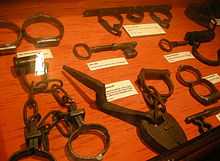Westgate, Canterbury
| Westgate | |
|---|---|
| West Gate Towers Museum | |
| Part of Canterbury city wall | |
| St Peter's Street, Canterbury, Kent CT1 2BQ | |
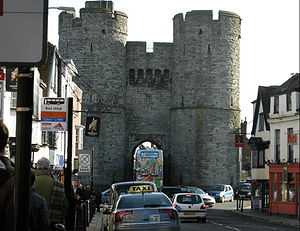 | |
| Westgate | |
| Type | Gateway in city wall |
| Site information | |
| Owner | Canterbury City Council |
| Controlled by | Canterbury City Council, leased to a private partnership in April 2011. |
| Open to the public |
West Gate Towers Museum established 1906, open every day 10am-4:30pm, temporarily closed for legal reasons[1] |
| Condition | well-preserved |
| Site history | |
| Built | 1380 |
| In use | 1380−present as pilgrim gateway, prison and museum |
| Built by | Archbishop Simon Sudbury |
| Materials | Kentish ragstone |
| Height | 60 feet |
| Battles/wars | Site of Roman gate against Cantiaci raids 300 AD |
The Westgate is a medieval gatehouse in Canterbury, Kent, England. This 60-foot-high western gate of the city wall is the largest surviving city gate in England. Built of Kentish ragstone around 1379, it is the last survivor of Canterbury's seven medieval gates, still well-preserved and one of the city's most distinctive landmarks. The road still passes between its drum towers, and there is just enough room for a double-decker bus to pass beneath. This scheduled monument and Grade I listed building houses the hundred-year-old West Gate Towers Museum, which as of July 2011 was open every day from 10am to 4:30pm, although it is currently closed for legal reasons. Access to the museum and roof is via spiral staircases only.
Gateway building
Building history
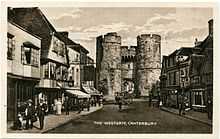
Canterbury was walled by the Romans around 300 AD. This has been consistently the most important of the city's gates as it is the London Road entrance and the main entrance from most of Kent. The present towers are a medieval replacement of the Roman west gate, rebuilt around 1380. There was a gate here at the time of the Norman conquest, which is thought to have been Roman. From late Anglo-Saxon times it had the Church of the Holy Cross on top, but both church and gate were dismantled in 1379, and the gate was rebuilt by Archbishop Simon Sudbury before he died in the Peasants' Revolt of 1381.[2][3][4] It has been suggested that it was built primarily as an entrance for pilgrims visiting the shrine of St Thomas Becket at the cathedral.[5] However the rebuild as a defensive status symbol was paid for partly by Sudbury and partly by taxation for military protection against expected raids by the French.[6] It has been suggested that the spiral staircases were built to the disadvantage of defenders going downstairs who would have had to fight invaders climbing up to their right: difficult with a one-handed sword in the right hand.[7]
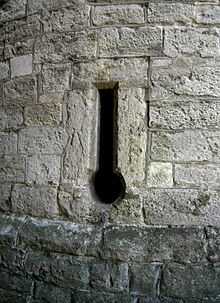
It is expensively faced in coursed ashlar of Kentish ragstone. It has battered plinths to the drum towers, battlements, machicolations and eighteen gunloops: a high number for a gateway, and among the earliest gunholes in Britain. The gunloops would have been added by the beginning of the fifteenth century. It had a drawbridge over the Stour, a portcullis and wooden doors.[6]
The gateway has three floors. The ground floor was designed so that the gateway and vaulted passage had entrances to the towers on each side. Each tower had a ground-floor room with fireplace and four gunloops. The north tower's ground-floor room had a spiral staircase to upper floors. The first floor contains a large room with fireplace and, originally, the portcullis mechanism over the vaulted entranceway. This room had doors to the upper room of each tower, each with fireplace and three gunloops, and a northern door to a spiral staircase leading to the roof. Repairs were carried out due to an invasion scare during the 1470s and 1480s. In 1491 or 1492 a large, two-light, transomed, perpendicular east window was added to the large first-floor room, with a view towards the cathedral and along St Peter's Street. The roof over the large first-floor central room has a battlemented parapet walk, originally with access to the tops of both towers and machicolations, as well as to the two low chambers, each with two gunports, in the tops of both towers. This part of the tower was less well-built than the lower storeys, either due to haste during the Peasants' Revolt or because it was built later. In 1793−1794 the hall over the gate was split into three and the present square lantern added to the roof, along with the wooden doors and cell linings which are visible today; the cost was £400.[6]
The city walls joined the gateway at the back of the drum towers, but this part of the wall was removed in the nineteenth century. Following this, in 1823−1829, a jailer's house was built on the north side, and this became a police station and is now a music school. The disused iron bridge which connects the Westgate with the music school dates from this time. Contemporary with this work was the building of St Peter's Place on the south side of the Westgate, along with passages around the Westgte and a new road across the Stour, to cope with increased traffic, which has been damaging the arch of the building for one hundred and fifty years.[6]
At the end of the 19th century the Westgate was a temporary repository for the city archives until the museum was opened in 1906.[8] It is the largest surviving city gate in England.[2][3][4][6]
Social history
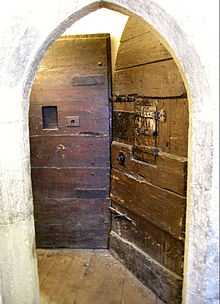

Canterbury's mayor and corporation were grateful to this martyr to the Revolt who had built them an additional attraction for pilgrims, and they would pray at his tomb or under the Westgate. The head of the rebellious Bluebeard the Hermit was displayed on Westgate in 1450 after he was caught by local people and sent to Henry VI. It is thought that Geoffrey Chaucer may have undertaken a pilgrimage and passed through the gate. In 1648 after the Christmas Day riot, Parliamentarians burnt down all the wooden doors of the city's gates. They were all replaced in 1660, but these replacements were removed at the end of the eighteenth century. They were similar to the surviving wooden Christ Church gates at the cathedral. Royalty have entered the city through the gate, including George VI in 1948.[2][6]
In 1453 Henry VI permitted the Mayor and Commonality to keep a jail at the Westgate, so the building was Canterbury's prison from the 15th to the 19th century, while Canterbury Castle was the county jail. After repairs to the Westgate and jail in 1667, a pound was built on the north side; this is now gone, but Pound Lane remains. The guard rooms, heavily wood-lined in the eighteenth century, became cells for both debtors and criminals, and the room over the arch became the condemned cell with the portcullis now laid on top. Until 1775 there was a grated cage in the prison gateway, where certain prisoners were allowed to beg for alms and speak with passers by. Capital punishment was normally the gallows, plus the stake at Wincheap for religious martyrs in the time of Queen Mary.[2][2]
Listing details
It is a Grade I listed building, HER number TR15NW155 at grid reference TR14595808. It is listed as a Roman site 43−409 AD; the site of the medieval Church of the Holy Cross 1066−1539 AD; the medieval gate built around 1400 AD. Only the gateway, currently in use as a museum, is standing.[9]
Buffs Regimental Museum
The Buffs Regimental Museum was inside West Gate Towers around 1960, before it removed to the Beaney. The director of Army Museums Ogilby Trust Dr Alan Guy says that the trust has long been interested in re-occupying the West Gate Towers, especially while its archives are partly held in storage in Canterbury, pending the re-opening of the Beaney in 2012.[10][11] Meanwhile the archives of the Queen's Own Royal West Kent Regiment are ensconced in Maidstone Museum, in mid-Kent.[12]
Museum
Management
The museum was leased by Canterbury City Council to a private partnership in April 2011.
Exhibits
The present museum was established in 1906,[8] and it currently displays weaponry in the guard chamber between the towers above the road. In recent years the towers were also open on Sunday afternoons.[13] The roof of one of the towers is accessible via a spiral staircase, and from there an extended view of Canterbury is visible from between the battlements. Exhibits include armaments from the English Civil War to World War II, original prison cells and murder holes by which defenders could kill enemies entering the gateway: boiling oil, molten lead, cannonballs and other material were dropped. The holes are now covered with thick glass, and cars and buses can be seen passing below. Replica armour is available for children to try on.[5]
Magna Carta maquettes
These are seventeen six-foot, painted, plaster-cast maquettes for the sixteen bronze barons and two bishops which today stand in the Lords Chamber at Westminster Palace; cast in 1847−1851.[14][15] These were made by various named sculptors, and represent the men who signed the Magna Carta: each of the fifteen barons and two bishops is named at the base. In 1908 three of the maquettes were displayed in the museum (see photo below), and two remain on show. The rest were put in storage and forgotten in the ground floor room of the north tower in 1987, along with several other museum exhibits, before being brought to the attention of museum staff in May 2008 after the building was flooded. The City of Canterbury museums department was said to have been attempting to remove them to safety for restoration, but was inhibited by logistics and funding.[16] The maquettes could have been left here because Archbishop of Canterbury Stephen Langton was one of the bishops who signed the Magna Carta,[17] leading to Canterbury being a charter town.[18] As of May 2011, ten of the maquettes in the basement have been photographed; the fate of the remaining five is unknown.[19]
The sculptors of the maquettes are as follows:[16]
- John Evan Thomas who created the bronze statue of the Duke of Wellington in Brecon, and statuary in Brecon Cathedral. His maquette is of Stephen Langton; as of 2013 it is in Canterbury Heritage Museum.
- Patrick MacDowell who carved the Europe allegorical group on the Albert Memorial;
- Henry Timbrell who carved bas reliefs on the garden house at Buckingham Palace;[20]
- James Sherwood Westmacott, sculptor of the Alexander the Great statue at Mansion House,[21] and Aristotle at the rear of Burlington House;[22]
- J. Thorneycroft. This could possibly be Thomas Thornycroft who sculpted the Boudica on Westminster Bridge.
- Frederick Thrupp, who sculpted the Sir Fowell Buxton and the Wordsworth in Westminster Abbey;[23]
- Alexander Handyside Ritchie: public sculpture in Edinburgh and Glasgow; Eustace de Vesci and William de Mowbray on the Houses of Parliament;[24]
- William Frederick Woodington, who sculpted the Coade Lion outside the County Hall on the South Bank.
-

Civil War armour
-

19th century maquette of Knight Templar St Maur who signed the Magna Carta
Events and exhibitions
In 2001 the museum held an exhibition on the Baedeker raids of World War II.[25]
Museum access
Rail: Canterbury West; Canterbury East
Buses: National Express; Stagecoach; Canterbury bus station
Road closure trial
A traffic management trial in the St Dunstans area of Canterbury took place from 27 March 2012. This included the temporary banning of traffic from passing through the Westgate.[26][27]
Projected closure
Having had its opening times reduced to just one day per week, the museum was under threat of closure as of 2009, pending a decision by Canterbury City Council on 18 February 2010. This caused widespread controversy.[28][29] In the event the Council voted to close the museums in 2011, but said it would fund them for the financial year 2010−2011 whilst working with other organisations to examine ways of keeping the museums open.[30][31][32][33][34][35]
Re-opening
Westgate Towers Museum was re-opened in April 2011 under the directorship of the late Charles Lambie,[36] who was also chairman of the trustees of Canterbury Archaeological Trust. Opening Hours are 10am to 4:30pm, every day. The museum will from July 2011 include a cafe with a glass roof set in the adjoining former 1830s jail which will provide a new extension to the museum. This extension will provide a physical respresentation of the prison reform movement, in proximity of both the earlier medieval cells and later 1830 cells which have remained largely unaltered. From July 2011 the museum became open every day once again.[37][38][39][40] However, it was temporarily closed for legal reasons as of January 25, 2012.

See also
- Herne Bay Museum
- Roman Museum
- Westgate Hall, Canterbury
- Whitstable Museum and Gallery
References
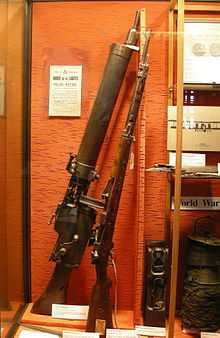
- ↑ Temporary Closure of The Westgate Towers and City Gaol Cafe
- ↑ 2.0 2.1 2.2 2.3 2.4 Bax, Stephen (2000). "Canterbury buildings". Westgate Tower. Retrieved 28 January 2010.
- ↑ 3.0 3.1 William Urry (1948). Canterbury Mayoral Quincentenary.
- ↑ 4.0 4.1 "City gates".
- ↑ 5.0 5.1 "Canterbury City Council Online". Canterbury West Gate Towers. CCC. 2009. Retrieved 28 January 2010.
- ↑ 6.0 6.1 6.2 6.3 6.4 6.5 Tatton-Brown, Tim; et al (September 1985). The Westgate (museum leaflet). Westgate Museum: Canterbury City Council.
- ↑ Information from museum staff
- ↑ 8.0 8.1 Kentish Gazette and Canterbury Press, June 1906
- ↑ "Exploring Kent's Past". HER number TR 15 NW 155. Kent County Council: Kent County Council. Retrieved 28 January 2010.
- ↑ "Army Museums Ogilby Trust". Buffs, Royal East Kent Regiment Museum Collection. updated 2010. Retrieved 10 February 2010.
- ↑ "Canterbury City Council Online". Canterbury Royal Museum & Art Gallery with Buffs Regimental Museum. 2009. Retrieved 10 February 2010.
- ↑ "Kent TV". Film: Maidstone Museum. February 2009. Retrieved 11 February 2010.
- ↑ Councillor Avery; Cllrs Ashmore, Law and Pepper (April 2007). "Canterbury City Council Short Topic Scrutiny Review". Westgate Towers Final Report. CCC. Retrieved 28 January 2010.
- ↑ "Parliament.co.uk". Living Heritage: Architecture of the palace: the Lord's Chamber. 2010. Retrieved 18 February 2010.
- ↑ "ThisIsKent.co.uk". Mystery statues found at Canterbury's Westgate Towers Museum. 23 February 2010. Retrieved 1 March 2010.
- ↑ 16.0 16.1 Information from records at the Museum of Canterbury
- ↑ John of England; Barons, bishops, abbots and others (1297 AD). "UK Statute Law Database". Magna Carta (1297) (c. 9). Retrieved 28 February 2010.
- ↑ Alexander, Glynis; Rob Davis, Steve James (February 2007). "District Life 2007". Crowds Expected for Magna Carta parade. Canterbury City Council. Retrieved 28 February 2010.
- ↑ "Canterbury Westgate Towers". Panorama of ten maquettes in Westgate Towers basement. Retrieved 31 May 2011.
- ↑ "Daniel Katz Ltd". Henry Timbrell (Dublin, 1806-1849) Venus and Cupid. 2006. Retrieved 19 February 2010.
- ↑ "Public Monument and Sculpture Association National Recording Project". Alexander the Great (Statue) 1861-63, Mansion House. Retrieved 19 February 2010.
- ↑ "MyWeb: Picadilly". Burlington House and the Royal Academy. Retrieved 19 February 2010.
- ↑ Retallick, Leslie (2004). "Torre Abbey: Catalogue of the Art Collections". Frederick Thrupp (1812-1895). Torbay Council Learning and Cultural Services Directorate. Retrieved 19 February 2010.
- ↑ Nisbet, Gary (2002). "GlasgowSculpture.com". Alexander Handyside Ritchie (1804-70). Retrieved 19 February 2010.
- ↑ "kent Online". Exhibition recalls dark days of the Blitz. 29 October 2001. Retrieved 21 February 2010.
- ↑ Canterbury City Council Online St Dunstans and Westgate traffic management trial – 27 March 2012
- ↑ Kentish Gazette 17 November 2011 Plans to ban traffic from passing through Westgate Towers revealed, by Alex Claridge
- ↑ Eyb, Lynette (8 February 2010). "The Independent". Canterbury's Roman Museum could fall victim to the credit crunch (Independent News and Media Limited). Retrieved 8 February 2010.
- ↑ "Canterbury Museums & Hall". City of Canterbury budget 2010−2011. April 2010. Retrieved 22 April 2010.
- ↑ Gilbey, John (10 February 2010). "Canterbury City Council Online". Museums budget statement. CCC. Retrieved 11 February 2010.
- ↑ "Canterbury City Council Online". Budget Consultation: Council sets next year's budget - 19 February 2010. 19 February 2010. Retrieved 19 February 2010.
- ↑ Finch, Graham (19 February 2010). "Canterbury City Council Online". Agenda Council Thursday, 18th February, 2010 7.00 pm. CCC. Retrieved 19 February 2010.
- ↑ Warren, Gerry (19 February 2010). "Kentish Gazette". Siege of Canterbury City Council. Retrieved 21 February 2010.
- ↑ "This is Kent: Herne Bay Times". Budget cuts approved by Canterbury City Council. 19 February 2010. Retrieved 25 February 2010.
- ↑ Liz Crudgington, "Bitter debate over 'realistic' budget", Herne Bay Times (Kent Messenger), p.7, 25 February 2010
- ↑ Wordpress report of death of Charles Lambie, January 2012
- ↑ {{cite news|url=http://www.thisiskent.co.uk/where/canterbury/Prices-soar-bid-save-museums/article-3114891-detail/article.html|title=Prices soar in bid to save museums|last=Blower|first=Nerissa|date=20 January 2011|work=Herne Bay Times|accessdate=22 January 2011}}
- ↑ Nerissa Blower (15 April 2011). "This is Kent". Open for visitors. Retrieved 9 May 2011.
- ↑ "This is Kent". The £1m museum tipped to be city's towering success. 18 February 2011. Retrieved 9 May 2011.
- ↑ Nerissa Blower (11 February 2011). "This is Kent". Retrieved 9 May 2011.
Bibliography
- Urry, William (1948), Canterbury Mayoral Quincentenary booklet (historical notes)
- Tatton-Brown, Tim, et al., (1985), The Westgate museum leaflet
External links

- Correct access map for West Gate Towers (Pointers to West Gate Towers Museum on many other maps, e.g. Google Earth, are incorrect)
- Canterbury City Council Online: Agenda for Exec Committee 21 January 2010 (includes link to audio recording of meeting)
- Canterbury Archaeological Trust official website
- Time Team: Roman and Saxon archaeology of Canterbury
- Time Team: Map of Roman Canterbury (West Gate Towers is "Westgate" on the left, next to the River Stour, as it is today)
- BBC panorama (showing Westgate towers, Church of the Holy Cross and River Stour)
- BBC panorama (showing Westgate towers from High Street)
- Canterbury City Council review of West Gate Towers 2007
- Parliament.uk: House of Lords Chamber virtual tour (showing arranged round the chamber 17 bronzes of lords and bishops who signed Magna Carta, of which the original maquettes are held at West Gate Towers Museum)
- Youtube: Video featuring busride through arch of Westgate at the beginning
Coordinates: 51°16′53″N 1°04′33″E / 51.28139°N 1.07583°E
| Wikimedia Commons has media related to Westgate Museum. |
| Wikimedia Commons has media related to Canterbury West Gate. |
| ||||||||||||||||||||
| |||||||||||||

